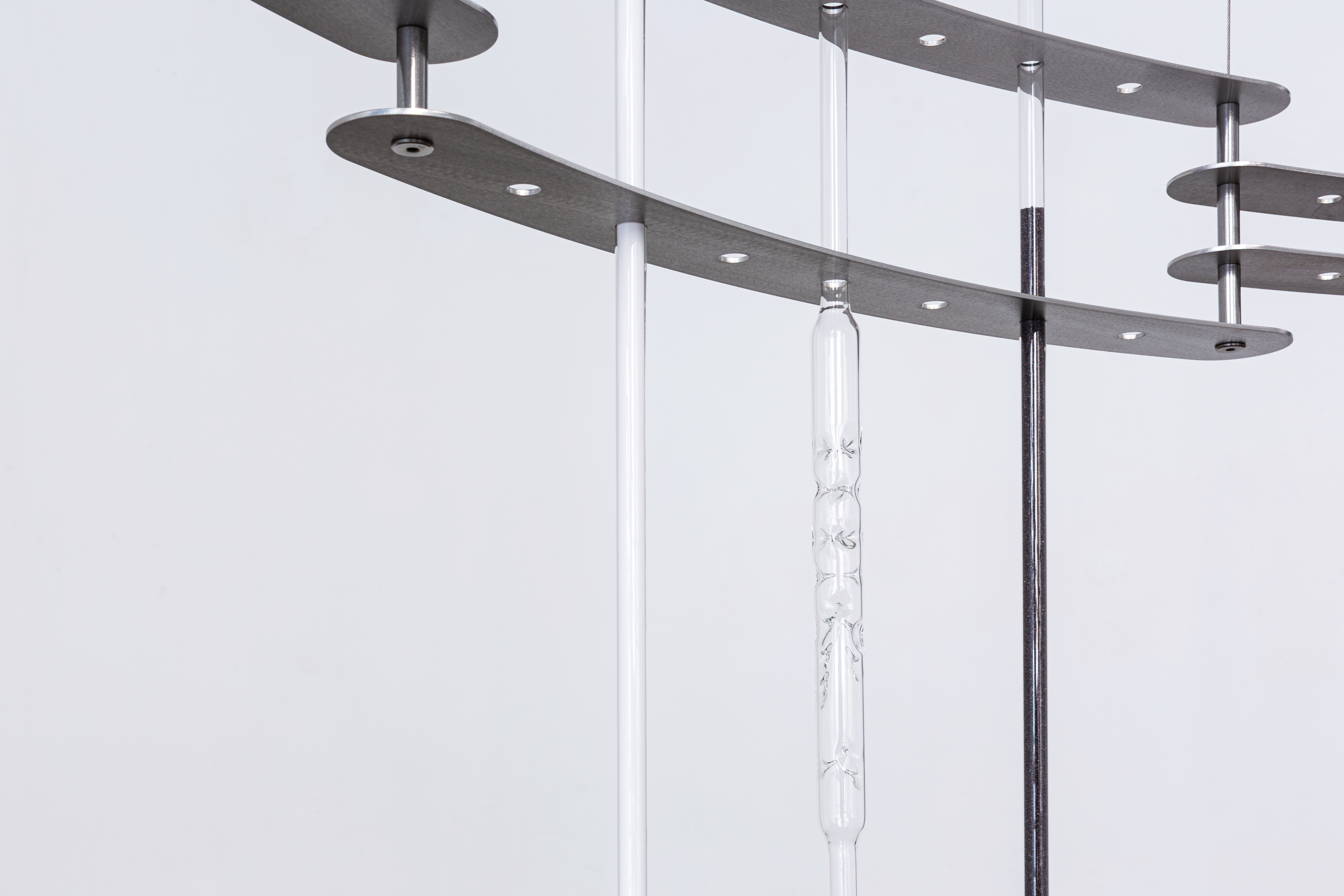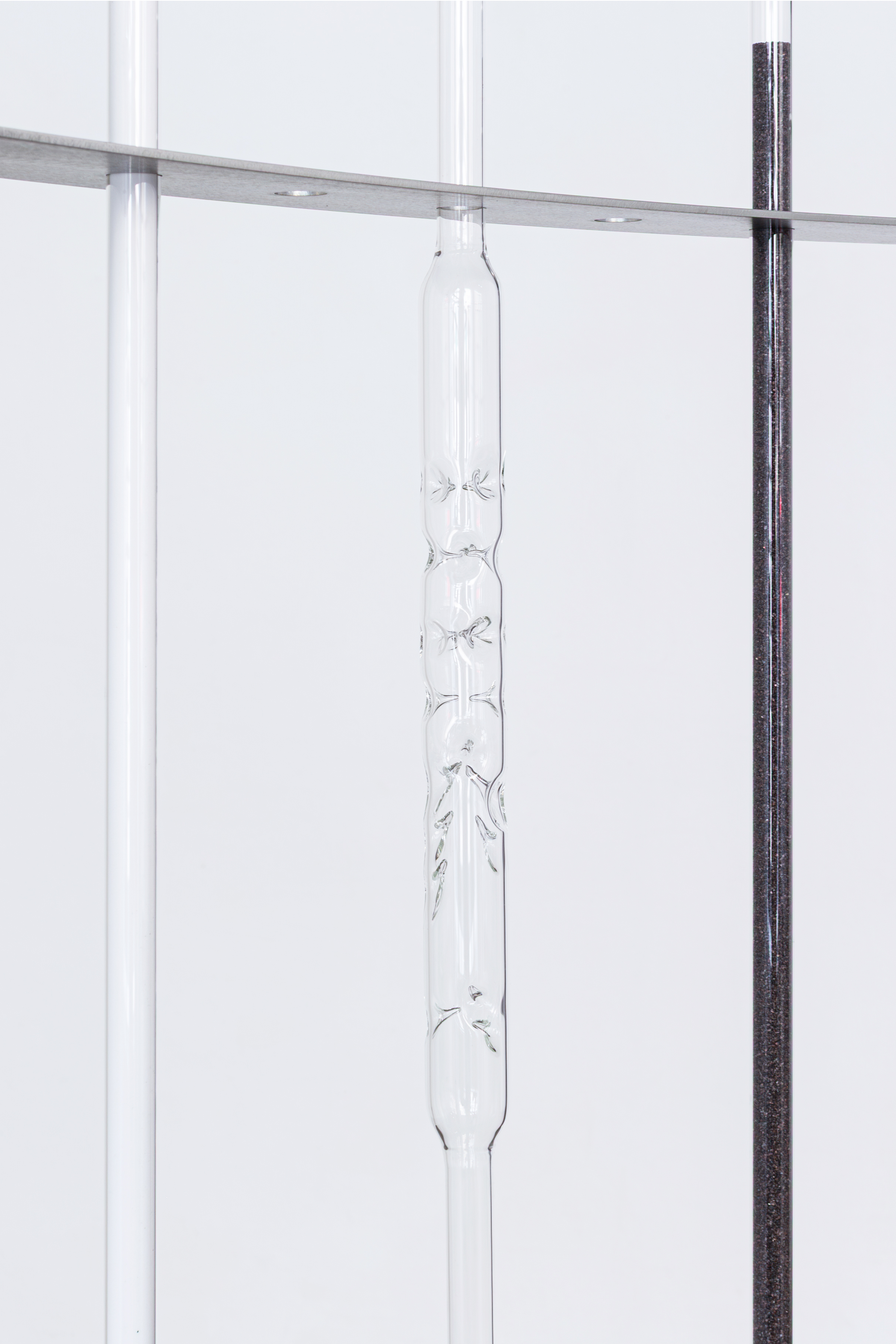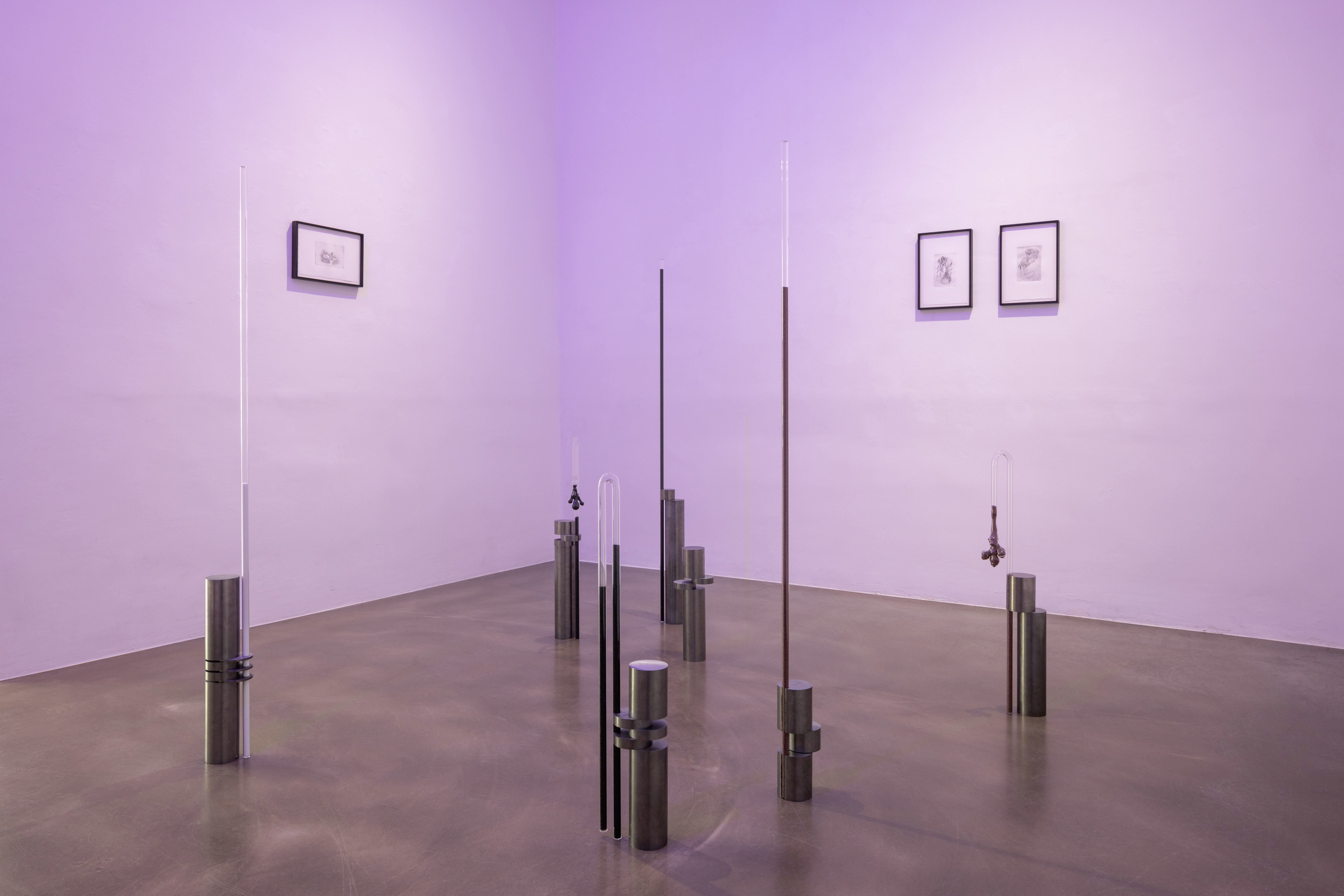May 27 - Aug 7, 2025
Bildraum 07, Vienna
curated by Esther Hladik
photography by Eva Kelety (1, 2, 3, 8, 9) & Bianca Phos (4, 5, 6, 7, 10)










Within Constellations
In the context of a critical post-humanist analysis, Bianca Phos examines the interplay of bodies, materials and technologies. In Within Constellations her sculptures, spatial installations and graphic series unfold at Bildraum 07 as socio-material assemblages and speculative archaeologies. Phos repeatedly allows time to seep into her works. Material poetics and artistic process intertwine to form zones of mimetic transformation, and it seems as if the works themselves are undergoing a kind of evolutionary development.
In the tension between technical precision and organic deviations, between aesthetic contour and fragility and in the reaction of the material - its yielding, resisting or collapsing - Bianca Phos negotiates dynamics that point beyond the purely physical. For example, the moment of drilling - formally realized in steel cylinders - not only penetrates into geological depths, but also opens up epistemic spaces. What comes to light when the material begins to make its own mark? Such articulated behavior is also revealed in the use of industrial abrasives - the silicates that are commonly used to remove surfaces under high pressure. This process culminates in the floating installation, a broken open system. Here, the material is in a state of uncertainty between the aggregates: sand and glass, originally identical, move to the center of an almost alchemical process that makes it possible to experience the transformation of materials in their elementary structure. The artist's deforming, cutting and piercing of the borosilicate glass vials and their disassembly into components leads to a new legibility - a fragmentary language that encompasses both desintegration and possibility.
Phos' sculptural and graphic works act as catalytic elements of a reflection on processes that are not only underway in nature, but also in social, cultural and political systems. With precise settings, she creates scenic arrangements that trace specific developments and power relations within our current transformation society. By playing with gravity, Phos makes tangible those forces that suggest profound upheavals - and initiate movements of thought. The materials are not only shaped, they shape themselves - they are emotionally charged actors within all the constellations created by Bianca Phos.
Text: Esther Hladik, 2025
A kind of Random Network Theory
Glitzersee, a former quarry near Kaltenleutgeben where cement was once sourced, is now home to rare amphibians and protected flora. Due to its unique ecosystem, recreational use of the lake has been prohibited since 2015, meaning swimming is no longer permitted to the disappointment of its human visitors. This artificial lake, which translates as 'Sparkling Lake' in English, has a charming beauty. Perhaps this is because the evolution of this quarry mirrors that of all our human-made surroundings at some point, from ecology to industry and from ruin to biotope. Sand also comes from quarries like this one. It is used in sandblasting and is a by-product of metal processing or glass production in industrial kilns. Glass is one of the oldest man-made materials, with beads and vessels dating back to 3500 BCE. However, it has only been used in construction for around 1,000 years.
Another 100 years passed before the first full-body, all-glass structure was built. More significantly, phosphate glass, referred to here as 'Phos' for short, is an inorganic material characterised by its structure of phosphate anion tetrahedra. Rather than existing as a single material, Phos exists as a range of components, each with a variety of properties. It can be transparent or opaque, chemically durable or bio-compatible. The interesting thing is that certain phosphate glasses can be used as degradable scaffolds for tissue and bone regeneration. In another 100 years from now, we may be able to build a human glass body. The different properties of Phos remind us of the idea that glass is never truly solid. It is said that it exists in permanent transition, like language or memory. An existence in a molecular in-between — Structurally chaotic yet visibly serene.
The perception of transparency in glass is affected by various factors. However, transparency is not the whole truth of this matter. The basic metric for transparency is the amount of light that passes through a material, known as transmission. In ordinary flat glass, transmission is nearly 84%, but this clarity is affected by factors such as thickness, colour, absorption, angle and history. While light enters, what we see is shaped by what the glass reflects or obscures. There is no such thing as a 'pure' material or a neutral lens — glass demonstrates the tension between containment and openness.
In contrast, metal has an organized, crystalline structure. And as opposed to the opaqueness of the metal components here I am drawn to the transparency of the glass. Phos’ metal brackets — laser-cut into form — hold the glass in tension. They are the necessary infrastructure, the clinical geometry to glass’ organic ambiguity. This contrast echoes the historical partnership between glass and metal in early architecture: glass once braced the iron structures of 19th-century buildings, becoming both envelope and structural actor. Here too, the brackets brace the vessels — yet they also echo quarry roads, the deep industrial grooves left by extraction.
The materials in these tubes are not arbitrary. They speak of geological memory and industrial present:
Granite, a coarse igneous rock, is a fragment of continental crust.
Quartz sand, mostly silicon dioxide, forms the foundation of glass and digital infrastructure alike.
Glass beads, re-melted and re-formed, are both decorative and utilitarian — a visual reference to recycled loops.
Blast furnace slag, a waste product of metal making, becomes an unlikely construction aggregate.
Asilit is a synthetic, mineral-based fine blasting abrasive made from fused slag.
In this way the glass vials are offering us a bracing of the near-full litany of glass’ origin story. They are not only serving the purpose of presentation but also of preservation of other aggregates of its own existence. Is the Stone Age contained in one of the jars? These containers become a fossilized moment in the transformation of substances — from igneous rock to silica, from sand to light. Echoes of a planetary interconnectedness. We may look at a vial and see sand, but we’re also seeing the desert, the quarry, the storm, the steel plant, the laboratory, and the body. Sand is not just a commodity — it is a state of matter, a liminal grain size. Below it lies clay, above it gravel. It is not a substance, but a classification.
These are samples, yes, but also éprouvettes, test tubes of time. A kind of tautological loop, where sand returns to sand, speaking only in aggregates of itself. To use sand in all its forms — from grain to transparency — becomes a circular production of meaning, a conceptual ouroboros. Matter becomes a metaphor. Clumps of particles become bodies. Aggregates become evidence. This nudges us towards the fact of our medical realities. When we fall ill, our Western body is still treated as a collection of individual parts.
Phos reminds us that to look at glass is to look through time. That the tools we use to observe the world, with lenses, probes, test tubes, are made of the very stuff they examine. That transparency is never neutral, and that even the clearest glass contains trace elements of history, of extraction. Less a display than a network — each aggregate node a story, each bracket a sentence, each vessel a pause between epochs. Matter is always in flux, that categories are impositions, and that meaning is formed not in substance, but in structure.
Storms from North Africa now carry Sahara dust as far as Vienna, reminding us that materials never remain local. They migrate too. On 15 April 2025, newspapers reported that the sky was red, coloured by dust at a concentration of up to three grams per square metre. Dust is not just a nuisance; it also carries nutrients such as iron and phosphorus. It fertilises forests and oceans. Should a nuclear bomb ever explode over Vienna's Saharan sand-filled sky in the future, the extreme heat would turn the sand particles into green, glassy balls, which would fall from the sky. By then, we will hopefully already have glass bodies for them to melt into the ground and envelop the green chunks of what is known as ‘trinitites’.
Words by Jennifer Gelardo
In response to Bianca Phos’ exhibition “Within Constellations”
In response to Bianca Phos’ exhibition “Within Constellations”